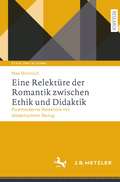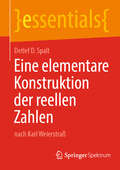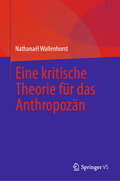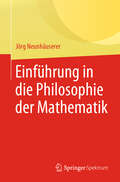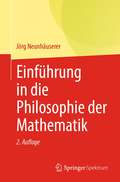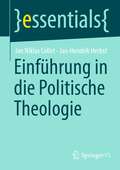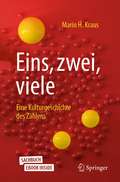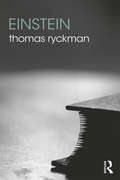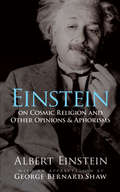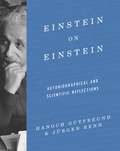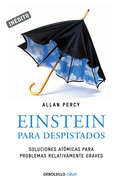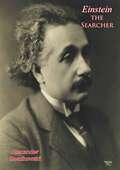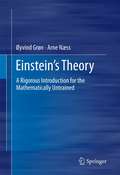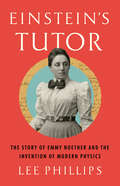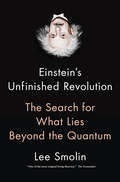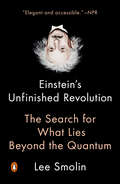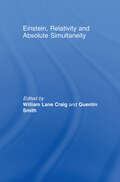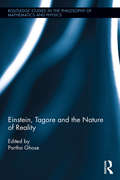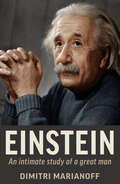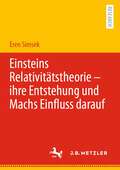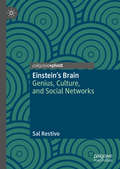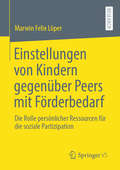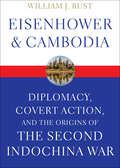- Table View
- List View
Eine Relektüre der Romantik zwischen Ethik und Didaktik: Postmoderne Relektüre mit didaktischem Bezug (Ethik und Bildung)
by Max BrinnichAn der Schnittstelle zwischen Philosophie, Literatur, Ethik und Ästhetik liegt in derphilosophischen Fach- und Literaturdidaktik ein nicht ausgeschöpftes Potential begraben –insbesondere im Umgang mit der literarischen Romantik. Diesem Potential spürt dievorliegende Arbeit nach, indem sie Schlegels „Lucinde“, Eichendorffs „Taugenichts“ undHoffmanns „Sandmann“ einer kritischen Relektüre unterzieht, um die in der philosophischenPostmoderne viel diskutierten Übergänge zwischen Ethik und Ästhetik sichtbar zu machenund ihre Bedeutung für die Fachdidaktik zu diskutieren.
Eine elementare Konstruktion der reellen Zahlen: nach Karl Weierstraß (essentials)
by Detlef D. SpaltDieses essential stellt in kondensierter Form eine Neuinterpretation der Weierstraß'schen Konstruktion der reellen Zahlen vor: Ein vergleichsweise neuer Quellenfund lässt darauf schließen, dass der Weierstraß’sche Zahlbegriff bereits auf Mengenbegriffen basierte und somit sehr viel elementarer ist, als bislang angenommen wurde.Die beiden bislang bekanntesten Alternativdefinitionen der reellen Zahlen – mittels rationaler Folgen und Konvergenz (Cantor) bzw. als Segmente (Dedekind) – werden hier ebenfalls kurz erläutert und mit der Weierstraß’schen Konstruktion verglichen.Eine ausführliche Darstellung anhand der Originalquellen findet sich in Spalt, Die Grundlegung der Analysis durch Karl Weierstraß (Springer Spektrum, 2022).
Eine kritische Theorie für das Anthropozän
by Nathanaël WallenhorstDieser Band, der in biogeophysikalischen Studien verwurzelt ist, befasst sich mit Konzepten des politischen Handelns im Anthropozän und der Spannung zwischen dem Wunsch, das prometheische Projekt der Moderne zu vollenden, und einem post-prometheischen Ansatz. Diese Arbeit untersucht die Idee einer anthropologischen Mutation der politischen Konsolidierung von einem "postprometheanischen Miteinander" zur Schaffung der Fähigkeit zum gemeinsamen Handeln. Das von Hannah Arendt entwickelte politische Denken über die conditio humana ist hier als Ressource für das Denken über die Menschheit im Sinne des menschlichen Abenteuers wichtig. Dieses hat drei Dimensionen: Hybris, Welt und Koexistenz, die sich jeweils auf die Logik des Profits des homo oeconomicus, die Logik der Verantwortung des homo collectivus und die Logik der Gastfreundschaft des homo religatus beziehen.. Die in diesem Buch skizzierte intellektuelle und politische Haltung ist eine Erweiterungder kritischen Theorie: Das Werk übt auch Kritik an dem, was in unserer Beziehung zur Welt ein Problem darstellt, und schlägt vor, wie es überwunden werden kann, wobei das Endziel die soziale Transformation ist. Der Autor schlägt einen Aufstand und eine anthropologische Konsolidierung der Politik vor, die auf der Wiederbelebung beruht, die durch das Teilen einer Konvivialität sowohl zwischen den Menschen als auch mit dem Nicht-Menschlichen hervorgerufen wird. Die Identifizierung der Konvivialität als ein Bildungsparadigma, um das Anthropozän zu überleben, gibt uns trotz dieses Erbes des Anthropozäns den dringend benötigten Grund zur Hoffnung. Neben dem Arendt'schen Denken stützt sich diese kritische Theorie für das Anthropozän auf das politische Denken mehrerer zeitgenössischer Autoren, darunter Maurice Bellet, Hartmut Rosa, Andreas Weber, Dominique Bourg und Christian Arnsperger. Dieser Band ist für Forscher des Anthropozäns von Interesse.
Einführung in die Philosophie der Mathematik
by Jörg NeunhäusererWelche Art von Gegenständen untersucht die Mathematik und in welchem Sinne existieren diese Gegenstände? Warum dürfen wir die Aussagen der Mathematik zu unserem Wissen zählen und wie lassen sich diese Aussagen rechtfertigen? Eine Philosophie der Mathematik versucht solche Fragen zu beantworten. In dieser Einführung stellen wir maßgebliche Positionen in der Philosophie der Mathematik vor und formulieren die Essenz dieser Positionen in möglichst einfachen Thesen. Der Leser erfährt, auf welche Philosophen eine Position zurückgeht und in welchem historischen Kontext diese entstand. Ausgehend von Grundintuitionen und wissenschaftlichen Befunden lässt sich für oder gegen eine These in der Philosophie der Mathematik argumentieren. Solche Argumente bilden den zweiten Schwerpunkt dieses Buchs. Das Buch soll den Leser dazu anregen, über die Philosophie der Mathematik nachzudenken und eine eigene Position zu formulieren und für diese zu argumentieren.
Einführung in die Philosophie der Mathematik
by Jörg NeunhäusererWelche Art von Gegenständen untersucht die Mathematik und in welchem Sinne existieren diese Gegenstände? Warum dürfen wir die Aussagen der Mathematik zu unserem Wissen zählen und wie lassen sich diese Aussagen rechtfertigen? Eine Philosophie der Mathematik versucht solche Fragen zu beantworten. In dieser Einführung stellen wir maßgebliche Positionen in der Philosophie der Mathematik vor und formulieren die Essenz dieser Positionen in möglichst einfachen Thesen. Der Leser erfährt, auf welche Philosophen eine Position zurückgeht und in welchem historischen Kontext diese entstand. Ausgehend von Grundintuitionen und wissenschaftlichen Befunden lässt sich für oder gegen eine These in der Philosophie der Mathematik argumentieren. Solche Argumente bilden den zweiten Schwerpunkt dieses Buchs. Das Buch soll den Leser dazu anregen, über die Philosophie der Mathematik nachzudenken und eine eigene Position zu formulieren und für diese zu argumentieren. Die zweite Auflage ist vollständig durchgesehen und um ein Kapitel zum Idealismus ergänzt.
Einführung in die Politische Theologie (essentials)
by Jan-Hendrik Herbst Jan Niklas ColletPolitische Theologie erlebt derzeit ein Revival: Nachdem es eine längere Zeit lang still um die Politische Theologie geworden war, erfreut sie sich – nicht zuletzt angesichts multipler Krisenerscheinungen – aktuell wieder eines wachsenden Interesses. Aber was ist „Politische Theologie“ eigentlich? Die Einführung bietet eine begriffsgeschichtliche Orientierung und systematische Einordnung dieses schillernden Begriffs, eine vertiefende Auseinandersetzung mit den Politischen Theologien des Staatsrechtlers Carl Schmitt und des katholischen Theologen Johann Baptist Metz sowie eine Reflexion ausgewählter gegenwärtiger Diskussionsbeiträge in der deutschsprachigen katholischen Theologie. Das Buch verdeutlicht die ungebrochene Aktualität und Relevanz fundierter wissenschaftlicher und öffentlicher Auseinandersetzungen mit der Politischen Theologie.
Eins, zwei, viele: Eine Kulturgeschichte des Zählens
by Mario H. KrausDieses Werk gibt einen Überblick über die Geschichte des Zählens, sowohl in mathematischen oder philosophischen als auch soziokulturellen Zusammenhängen. Die Frage "Warum und wie zählen wir eigentlich?" wird vielfältig untersucht und beantwortet. Bewusst kurz und unterhaltsam soll das Buch auch Anwendungen zeigen - im Alltag, in der Wissenschaft oder bei Volkszählungen und in der Stadtentwicklung.
Einstein (The Routledge Philosophers)
by Thomas RyckmanAlbert Einstein (1879–1955) was the most influential physicist of the 20th century. Less well known is that fundamental philosophical problems, such as concept formation, the role of epistemology in developing and explaining the character of physical theories, and the debate between positivism and realism, played a central role in his thought as a whole. Thomas Ryckman shows that already at the beginning of his career - at a time when the twin pillars of classical physics, Newtonian mechanics and Maxwell’s electromagnetism were known to have but limited validity - Einstein sought to advance physical theory by positing certain physical principles as secure footholds. That philosophy produced his greatest triumph, the general theory of relativity, and his greatest failure, an unwillingness to accept quantum mechanics. This book shows that Einstein’s philosophy grew from a lifelong aspiration for a unified theoretical representation encompassing all physical phenomena. It also considers how Einstein’s theories of relativity and criticisms of quantum theory shaped the course of 20th-century philosophy of science. Including a chronology, glossary, chapter summaries, and suggestions for further reading, Einstein is an ideal introduction to this iconic figure in 20th-century science and philosophy. It is essential reading for students of philosophy of science, and is also suitable for those working in related areas such as physics, history of science, or intellectual history.
Einstein and the Quantum Revolutions (The France Chicago Collection)
by Alain AspectA Nobel laureate offers a brief lesson on physics’ biggest mystery, accessibly explaining the two quantum revolutions that changed our understanding of reality. At the start of the twentieth century, the first quantum revolution upset our vision of the world. New physics offered surprising realities, such as wave-particle duality, and led to major inventions: the transistor, the laser, and today’s computers. Less known is the second quantum revolution, arguably initiated in 1935 during a debate between giants Albert Einstein and Niels Bohr. This revolution is still unfolding. Its revolutionaries—including the author of this short accessible book, Nobel Prize–winning physicist Alain Aspect—explore the notion of entangled particles, able to interact at seemingly impossible distances. Aspect’s research has helped to show how entanglement may both upend existing technologies, like cryptography, and usher in entirely new ones, like quantum computing. Explaining this physics of the future, this work tells a story of how philosophical debates can shape new realities.
Einstein on Cosmic Religion and Other Opinions and Aphorisms
by George Bernard Shaw Albert EinsteinScience and religion are compatible, declares the famous physicist. In these essays, Einstein views science as the basis for a "cosmic" religion, embraced by scientists, theologians, and all who share a sense of wonder in the rationality and beauty of the universe. In the course of his career, Einstein wrote more than 300 scientific and 150 nonscientific publications. These essays date from the 1930s and 40s. In direct, everyday language the author develops a coherent view that transcends both the antiquated religion of fear and the modern religion of ethics. His concept of cosmic religion combines science and religion, with science forming the basis for a more enlightened religion. In these essays and aphorisms, Einstein also reflects on pacifism, disarmament, and Zionism. In addition to a brief biography of the author, this volume includes a warm appreciation by George Bernard Shaw.
Einstein on Einstein: Autobiographical and Scientific Reflections
by Hanoch Gutfreund Jürgen RennNew perspectives on the iconic physicist's scientific and philosophical formationAt the end of World War II, Albert Einstein was invited to write his intellectual autobiography for the Library of Living Philosophers. The resulting book was his uniquely personal Autobiographical Notes, a classic work in the history of science that explains the development of his ideas with unmatched warmth and clarity. Hanoch Gutfreund and Jürgen Renn introduce Einstein's scientific reflections to today's readers, tracing his intellectual formation from childhood to old age and offering a compelling portrait of the making of a philosopher-scientist.Einstein on Einstein features the full English text of Autobiographical Notes along with incisive essays that place Einstein's reflections in the context of the different stages of his scientific life. Gutfreund and Renn draw on Einstein's writings, personal correspondence, and critical writings by Einstein's contemporaries to provide new perspectives on his greatest discoveries. Also included are Einstein's responses to his critics, which shed additional light on his scientific and philosophical worldview. Gutfreund and Renn quote extensively from Einstein's initial, unpublished attempts to formulate his response, and also look at another brief autobiographical text by Einstein, written a few weeks before his death, which is published here for the first time in English.Complete with evocative drawings by artist Laurent Taudin, Einstein on Einstein illuminates the iconic physicist's journey to general relativity while situating his revolutionary ideas alongside other astonishing scientific breakthroughs of the twentieth century.
Einstein para despistados: Soluciones atómicas para problemas relativamente graves (Genios para la vida cotidiana #Volumen)
by Allan PercyEn Einstein para despistados, de la serie «Genios para la vida cotidiana», el prestigioso Allan Percy recoge 85 grandes reflexiones de este genio y las traslada a situaciones prácticas de la vida cotidiana. Sin lugar a dudas, la figura de Albert Einstein ha trascendido el ámbito de la ciencia para convertirse en un icono de la cultura moderna, comparable a las estrellas del pop o a los grandes actores de Hollywood. Y no solo por su peculiar peinado, ni por haber ganado un Premio Nobel, ni siquiera por ser el padre de la teoría de la relatividad. Además de haber revolucionado la física, Einstein fue un acérrimo defensor de la paz y un brillante pensador sobre el arte de vivir. Sus lúcidos aforismos para el día a día reflejan la sabiduría de alguien que siempre tuvo los pies en la tierra. Dentro y fuera del ámbito académico, Albert Einstein era por encima de todo un solucionador de problemas. En los tiempos que corren, en los que la presión es máxima y la compensación escasa, las enseñanzas de este físico nos ayudarán a apagar más de un fuego.
Einstein the Searcher: His Work Explained From Dialogues With Einstein
by Alexander MoszkowskiThis book, originally published in 1921, is written as an introduction of the theory of relativity of Albert Einstein. Moszkowski wrote the book in a way simple to understand for everyone. He developed the content in close personal discussions and it offers a wonderful view into the human Albert Einstein and his life and work. The writer Alexander Moszkowski lived from 1851 to 1934. He was born in Pilica (Poland), lived most of his life in Germany. Moszkowski was well known with Albert Einstein and probably the first author to open Einstein's theory of relativity to a wide audience.-Print ed.
Einstein's Opponents
by Milena Wazeck Geoffrey S. KobyThis detailed account of the controversy surrounding the publication of Albert Einstein's theory of relativity explores the ferocious popular and academic opposition which at one time encircled one of the most important scientific breakthroughs of the twentieth century. Based on extensive archival research, this fascinating discourse includes a compelling and entertaining examination of the contemporary literature created by Einstein's detractors. Exploring the arguments and strategies, social contexts, and motivations of Einstein's detractors, and providing unique insights into the dynamics of scientific controversies, this book is ideal for anyone interested in the history and philosophy of physics, popular science, and the public understanding of science.
Einstein's Theory
by Øyvind Grøn Arne NæssThis book provides an introduction to the theory of relativity and the mathematics used in its processes. Three elements of the book make it stand apart from previously published books on the theory of relativity. First, the book starts at a lower mathematical level than standard books with tensor calculus of sufficient maturity to make it possible to give detailed calculations of relativistic predictions of practical experiments. Self-contained introductions are given, for example vector calculus, differential calculus and integrations. Second, in-between calculations have been included, making it possible for the non-technical reader to follow step-by-step calculations. Thirdly, the conceptual development is gradual and rigorous in order to provide the inexperienced reader with a philosophically satisfying understanding of the theory. The goal of this book is to provide the reader with a sound conceptual understanding of both the special and general theories of relativity, and gain an insight into how the mathematics of the theory can be utilized to calculate relativistic effects.
Einstein's Tutor: The Story of Emmy Noether and the Invention of Modern Physics
by Lee PhillipsA revelatory story of the woman who made foundational contributions to science and mathematics and persevered in the face of discrimination. Emmy Noether's mathematical genius enabled Einstein to bring his General Theory of Relativity–the basis of our current theory of gravity–to fruition. On a larger scale, what came to be known as &“Noether&’s Theorem&”—called by a Nobel laureate &“the single most profound result in all of physics&”—supplied the basis for the most accurate theory in the history of physics, the Standard Model, which forms our modern theory of matter. Noether&’s life story is equally important and revelatory in understanding the pernicious nature of sexual prejudice in the sciences, revealing the shocking discrimination against one of the true intellectual giants of the twentieth century, a woman effectively excluded from the opportunities given to her male counterparts. Noether&’s personality and optimistic spirit, as Lee Phillips reveals, enabled her unique genius to persevere and arrive at insights that still astonish those who encounter them a century later.
Einstein's Unfinished Revolution: The Search for What Lies Beyond the Quantum
by Lee SmolinA daring new vision of the quantum universe, and the scandals controversies, and questions that may illuminate our future--from Canada's leading mind on contemporary physics.Quantum physics is the golden child of modern science. It is the basis of our understanding of atoms, radiation, and so much else, from elementary particles and basic forces to the behaviour of materials. But for a century it has also been the problem child of science, plagued by intense disagreements between its intellectual giants, from Albert Einstein to Stephen Hawking, over the strange paradoxes and implications that seem like the stuff of fantasy. Whether it's Schrödinger's cat--a creature that is simultaneously dead and alive--or a belief that the world does not exist independently of our observations of it, quantum theory is what challenges our fundamental assumptions about our reality. In Einstein's Unfinished Revolution, globally renowned theoretical physicist Lee Smolin provocatively argues that the problems which have bedeviled quantum physics since its inception are unsolved for the simple reason that the theory is incomplete. There is more, waiting to be discovered. Our task--if we are to have simple answers to our simple questions about the universe we live in--must be to go beyond it to a description of the world on an atomic scale that makes sense. In this vibrant and accessible book, Smolin takes us on a journey through the basics of quantum physics, introducing the stories of the experiments and figures that have transformed the field, before wrestling with the puzzles and conundrums that they present. Along the way, he illuminates the existing theories about the quantum world that might solve these problems, guiding us toward his own vision that embraces common sense realism. If we are to have any hope of completing the revolution that Einstein began nearly a century ago, we must go beyond quantum mechanics as we know it to find a theory that will give us a complete description of nature. In Einstein's Unfinished Revolution, Lee Smolin brings us a step closer to resolving one of the greatest scientific controversies of our age.
Einstein's Unfinished Revolution: The Search for What Lies Beyond the Quantum
by Lee SmolinA daring new vision of quantum theory from one of the leading minds of contemporary physicsQuantum physics is the golden child of modern science. It is the basis of our understanding of atoms, radiation, and so much else, from elementary particles and basic forces to the behavior of materials. But for a century it has also been the problem child of science: it has been plagued by intense disagreements between its inventors, strange paradoxes, and implications that seem like the stuff of fantasy. Whether it's Schrödinger's cat--a creature that is simultaneously dead and alive--or a belief that the world does not exist independently of our observations of it, quantum theory challenges our fundamental assumptions about reality. In Einstein's Unfinished Revolution, theoretical physicist Lee Smolin provocatively argues that the problems which have bedeviled quantum physics since its inception are unsolved and unsolvable, for the simple reason that the theory is incomplete. There is more to quantum physics, waiting to be discovered. Our task--if we are to have simple answers to our simple questions about the universe we live in--must be to go beyond quantum mechanics to a description of the world on an atomic scale that makes sense. In this vibrant and accessible book, Smolin takes us on a journey through the basics of quantum physics, introducing the stories of the experiments and figures that have transformed our understanding of the universe, before wrestling with the puzzles and conundrums that the quantum world presents. Along the way, he illuminates the existing theories that might solve these problems, guiding us towards a vision of the quantum that embraces common sense realism. If we are to have any hope of completing the revolution that Einstein began nearly a century ago, we must go beyond quantum mechanics to find a theory that will give us a complete description of nature. In Einstein's Unfinished Revolution, Lee Smolin brings us a step closer to resolving one of the greatest scientific controversies of our age.
Einstein, Relativity and Absolute Simultaneity (Routledge Studies in Contemporary Philosophy)
by William Lane Craig Quentin SmithEinstein, Relativity and Absolute Simultaneity is an anthology of original essays by an international team of leading philosophers and physicists who have come together to reassess the contemporary paradigm of the relativistic concept of time. A great deal has changed since 1905 when Einstein proposed his Special Theory of Relativity, and this book offers a fresh reassessment of Special Relativity’s relativistic concept of time in terms of epistemology, metaphysics, and physics.
Einstein, Tagore and the Nature of Reality: Literary And Philosophical Reflections (Routledge Studies in the Philosophy of Mathematics and Physics)
by Partha GhoseThe nature of reality has been a long-debated issue among scientists and philosophers. In 1930, Rabindranath Tagore and Albert Einstein had a long conversation on the nature of reality. This conversation has been widely quoted and discussed by scientists, philosophers and scholars from the literary world. The important question that Tagore and Einstein discussed was whether the world is a unity dependent on humanity, or the world is a reality independent on the human factor. Einstein took the stand adopted by Western philosophers and mathematicians, namely that reality is something independent of the mind and the human factor. Tagore, on the other hand, adopted the opposite view. Nevertheless, both Einstein and Tagore claimed to be realists despite the fundamental differences between their conceptions of reality. Where does the difference lie? Can it be harmonized at some deeper level? Can Wittgenstein, for example, be a bridge between the two views? This collection of essays explores these two fundamentally different conceptions of the nature of reality from the perspectives of theories of space-time, quantum theory, general philosophy of science, cognitive science and mathematics.
Einstein: An Intimate Study of a Great Man
by Dimitri Marianoff Palma WayneEinstein: An Intimate Study of a Great Man, first published in 1944, recounts the personal life of physicist Albert Einstein (1879-1955). The book was written by Einstein’s son-in-law, who married his daughter Margot in Berlin in 1930. Einstein was a simple, direct man, but remains today larger-than-life, and as author Marianoff writes, “Einstein’s life is not an exciting one. It is not filled with the rush and sweep of spectacular adventures. It has none of the scope and danger of the explorer, who freezes and suffers and agonizes in his search. It is not filled with the stir and headiness of eventful, flamboyant episodes. It is not a colorful panorama of the human pilgrimage...It has no color at all except the color of greatness...It is a mighty epic journey of science—a steady, breathtaking march whose heroic altitude is of such heights that it precludes the ecstatic language so often applied to singular human endeavors...It has no thrill in it, except the thrill of having changed the tide of man’s history and created new channels for his growth...It has no drama in it, except the overpowering drama of a conquest so immeasurable that as long as man remains on earth he will have benefited by it.”
Einsteins Relativitätstheorie – ihre Entstehung und Machs Einfluss darauf
by Eren SimsekRoman U. Sexl schreibt in seinem Artikel „Der unerschöpfliche Albert Einstein“, dass „gerade rund um die Ursprünge der speziellen Relativitätstheorie einige wesentliche wissenschaftsgeschichtliche Fragen“ noch offen stehen und betont: „Eine der interessantesten Fragen betrifft die Quellen Einsteins.“ Von ihm kommt der wichtige Hinweis, sich Einsteins Kyoto-Rede bzw. die „, inoffizielle Nobelpreisrede‘“ näher anzusehen. Diese Rede, in welcher Einstein genau vor hundert Jahren die Entstehungsgeschichte der Relativitätstheorie erläutert, ist von größerem Interesse, weil Einstein darin oft auf Mach hinweist. Weder der historische Kontext der Rede wurde bis jetzt untersucht noch der Versuch unternommen, den Inhalt der Rede zu rekonstruieren. Betrachtet man den historischen Kontext, erweist sich dieser Vortrag nämlich zum Teil als Einsteins Reaktion auf das (gefälschte) Vorwort in Die Prinzipien der physikalischen Optik, worin E. Mach als Relativitätstheorie-Gegner dargestellt wurde. Einstein macht in seiner Rede darauf aufmerksam, welch wichtige erkenntnistheoretische Rolle Machs Arbeiten für ihn hatten. Aufgrund der neuen Ergebnisse in der Mach-Einstein-Forschung werden in dieser Arbeit daher die Entstehungsgeschichte der Relativitätstheorie sowie der Inhalt der Kyoto-Rede wissenschaftsgeschichtlich rekonstruiert und Machs Einfluss darauf genauer analysiert.
Einstein’s Brain: Genius, Culture, and Social Networks
by Sal RestivoThis book reviews the research on Einstein’s brain from a sociological perspective and in the context of the social brain paradigm. Instead of “Einstein, the genius of geniuses” standing on the shoulders of giants, Restivo proposes a concept of Einstein the social being standing on the shoulders of social networks. Rather than challenging Einstein’s uniqueness or the uniqueness of his achievements, the book grounds Einstein and his achievements in a social ecology opposed to the myths of the “I,” individualism, and the very idea of “genius.” “Einstein” is defined by the particular configuration of social networks that he engaged as his life unfolded, not by biological inheritances.
Einstellungen von Kindern gegenüber Peers mit Förderbedarf: Die Rolle persönlicher Ressourcen für die soziale Partizipation
by Marwin Felix LöperDie Einstellungen von Grundschulkindern gegenüber Peers mit Förderbedarf stellen eine wichtige Voraussetzung für die soziale Partizipation von Kindern mit emotional-sozialem Förderbedarf im inklusiven Grundschulunterricht dar. Vor diesem Hintergrund geht Marwin Felix Löper in diesem Buch der Frage nach, ob und inwiefern sich die Einstellungen von Grundschulkindern gegenüber Peers mit emotional-sozialem Förderbedarf durch ihre Empathie, ihren bisherigen Kontakt zu Menschen mit Förderbedarf und ihr soziales Selbstkonzept erklären lassen. Hierbei konnte er nachweisen, dass die Fürsorglichkeit – als Teil der Empathie – und der Kontakt zu Menschen mit Förderbedarf prädiktiv für die Einstellungen von Grundschulkindern zu Peers mit emotional-sozialem Förderbedarf sind.
Eisenhower & Cambodia: Diplomacy, Covert Action, and the Origins of the Second Indochina War (Studies In Conflict, Diplomacy, And Peace Ser.)
by William J. RustThis historical study examines America’s Cold War diplomacy and covert operations intended to lure Cambodia from neutrality to alliance.Although most Americans paid little attention to Cambodia during Dwight D. Eisenhower’s presidency, the global ideological struggle with the Soviet Union guaranteed US vigilance throughout Southeast Asia. Cambodia’s leader, Norodom Sihanouk, refused to take sides in the Cold War, a policy that disturbed US officials. From 1953 to 1961, his government avoided the political and military crises of neighboring Laos and South Vietnam. However, relations between Cambodia and the United States suffered a blow in 1959 when Sihanouk discovered CIA involvement in a plot to overthrow him. The failed coup only increased Sihanouk’s power and prestige, presenting new foreign policy challenges in the region.In Eisenhower and Cambodia, William J. Rust demonstrates that covert intervention in the political affairs of Cambodia proved to be a counterproductive tactic for advancing the United States’ anticommunist goals. Drawing on recently declassified sources, Rust skillfully traces the impact of “plausible deniability” on the formulation and execution of foreign policy. His meticulous study not only reveals a neglected chapter in Cold War history but also illuminates the intellectual and political origins of US strategy in Vietnam and the often-hidden influence of intelligence operations in foreign affairs.
